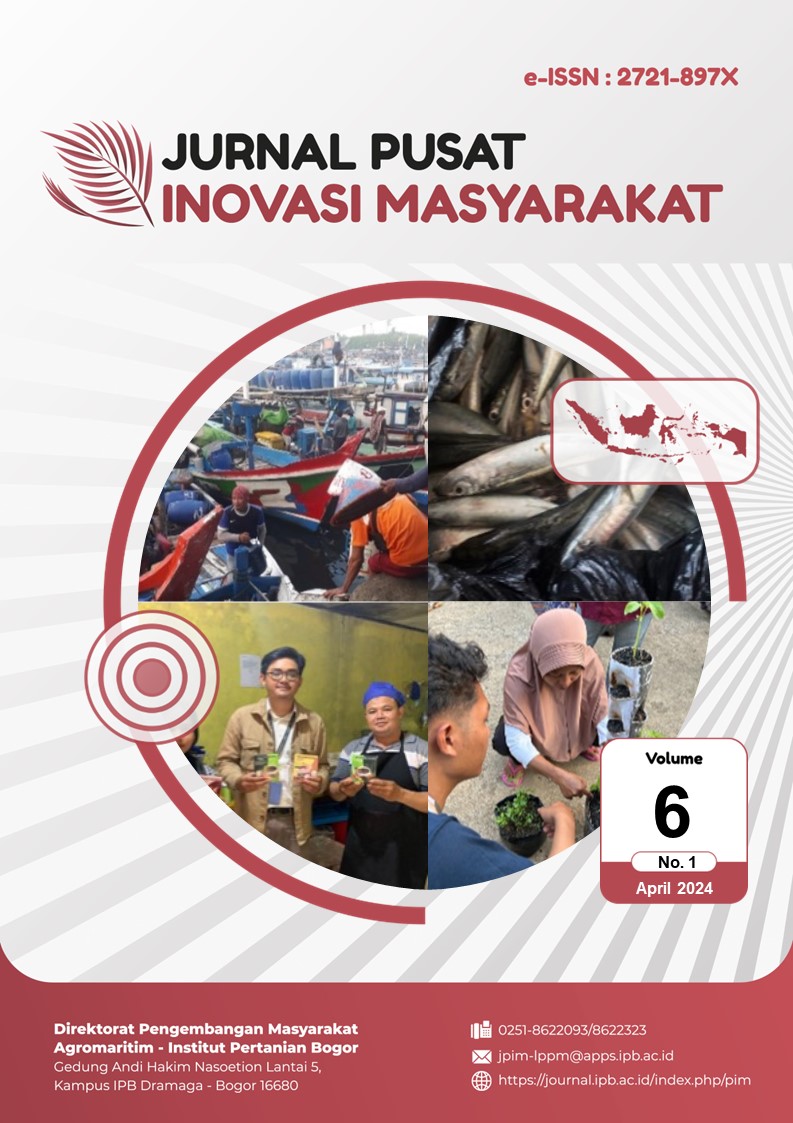Optimalisasi Pertanian melalui Pemanfaatan Lahan Sempit dan Pengolahan Sampah Organik di Kampung Cicere, Cigudeg
Abstract
The village of Cicere in Bogor Regency faces environmental issues due to excessive chemical fertilizers and waste burning. Excessive use of chemical fertilizers degrades soil quality, while waste burning produces harmful pollutants. To address these issues, Kampung Cicere has become a model village for the SI-LEISA program (System Integration-Low External Input Sustainable Agriculture), which includes yard gardening socialization, waste sorting, composting, and vertical farming. This program is implemented through socialization and direct demonstrations to the residents of Kampung Cicere. The gardening socialization involves participants and focuses on waste sorting, composting, and vertical farming. Waste sorting is conducted door-to-door, producing organic waste processed into compost. The composting initiative has been successful, with the produced compost meeting the success indicators. The vertical farming program has also been successfully implemented, with plants growing well, albeit slightly smaller than those grown using conventional methods. The implementation of the SI-LEISA program received a positive response from the community. Utilizing yard space for vegetable cultivation has the potential to improve family food security and maintain environmental sustainability. The ease of implementation enhances the program's sustainability potential.
Downloads
References
Aziz MF, Abdurrachman A, Chandra I, Majid LI, Vaicdan F, Salam RA. 2020. Pemantauan konsentrasi gas (CO2, No2) dan Partikulat (PM2.5) pada struktur horizontal di Kawasan Dayeuhkolot, Cekungan Udara Bandung Raya. Jurnal Sains Dirgantara. 18(1): 1‒12.
Arlius A, Sudargo T, Subejo. 2017. Hubungan ketahanan pangan keluarga dengan status gizi balita (Studi di Desa Palasari dan Puskesmas Kecamatan Legok, Kabupaten Tangerang). 23(3): 359‒375. https://doi.org/10.22146/jkn.25500
Dahlianah I. 2015. Pemanfaatan sampah organik sebagai bahan baku pupuk kompos dan pengaruhnya terhadap tanaman dan tanah. Klorofil: Jurnal Ilmu - Ilmu Agroteknologi. 10(1): 10‒13.
Das B, Bhave PV, Sapkota A, Byanju RM. 2018. Estimating emissions from open burning of municipal solid wate in municipalities of Nepal. Waste Management. 79(18): 481‒490. https://doi.org/10.1016/j.wasman.2018.08.013
Dewi DS, Afrida E. 2022. Kajian respon penggunaan pupuk organik oleh petani guna mengurangi ketergantungan terhadap pupuk kimia. Journal Liaison Academia and Sosiety. 2(4): 130‒135. https://doi.org/10.58939/afosj-las.v2i4.458
Ernawaty, Zulkarnain, Siregar YI, Bahruddin. 2019. Pengelolaan sampah di Kota Pekanbaru. Dinamika Lingkungan Indonesia. 6(2): 126‒135. https://doi.org/10.31258/dli.6.2.p.126-135
Hardyan R, Sasmita E, Yenie. 2016. Prediksi sebaran partikulat insinerator RSUD Arifin Achmad menggunakan Screen View. Jurnal Online Mahasiswa Fakultas Teknik Universitas Riau. 13(1): 1‒6.
Junaidah, Suryanto P, Budadi. 2015. Komposisi jenis dan fungsi pekarangan (Studi kasus Desa Giripuro, Kecamatan Girimulyo. DI Yogyakarta. Jurnal Hutan Tropis. 4(1): 77‒84. https://doi.org/10.20527/jht.v4i1.2884
Widarto L. 2016. Vertikultur Bercocok Tanam Secara Bertingkat. Jakarta (ID): Penebar Swadaya.
Widowati L. R. et al. 2022. Pupuk Organik Dibuatnya Mudah, Hasil Tanam Melimpah. Kementerian Pertanian Republik Indonesia.
Youssef MMA, Eissa MFM. 2014. Biofertilizers and their role in management of plant parasitic nematodes. A review. E3 Journal of Biotechnology and Pharmaceutical Research. 5(1): 1‒6.








